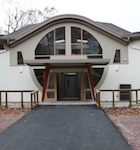Renaissance Pointe had significant blight and was identified as a Neighborhood Strategy Revitalization Area. In 2005, the city acquired a large number of rental homes and tore them down. In 2006, they invited three builders, including our Ideal Suburban Homes company, to build new homes. Six model homes—two by each builder—were constructed in 2007. As we know, the rug got pulled out from under the homebuilding industry in 2007. The credit crisis followed a year later. A few homes got sold, but it was clear that traditional home development was not the right strategy in that economy.
In 2010 we offered a new plan based on the tax-credit expertise of our Biggs TC Development business. Using Section 42 tax-credit funding that allows lease-purchase development, we proposed building 66 single-family homes that would be available for purchase after 15 years. That would help rebuild the neighborhood, promote homeownership, and provide work for Ideal Suburban Homes.
The city and neighborhood approved our plan, and we applied for 2011 tax credits. After receiving the tax credits from the state, we quickly found an equity partner to buy those credits, and we broke ground in September 2011. By the first quarter of 2012, we had foundations built for all 66 homes, with 13 homes completed and occupied. We’ll deliver eight homes per month to our Biggs Property Management company to rent until they are all full, roughly a year from the start date.
“It’s not only a good project for our company; it’s a timely project in this economy.”
Kevan Biggs, president
Home construction has followed the city’s pattern book for the neighborhood. New homes must be architecturally compliant with existing homes scattered among the vacant lots. That includes raised foundations with crawl spaces, trim around the doors, windows with contrasting color, and siding that is compliant with surrounding homes. Every home must have a front porch, and, in fact, the tagline for Renaissance Pointe is “A Front Porch Community.”
We’re building three models in sizes ranging from 1,280 to 1,650 square feet: a ranch model called the Brentwood, a true two-story called the Roosevelt, and a bungalow called the Claymore. Each model has two different elevations, and 10 percent will be fully ADA compliant. Rents range from $274 to $674 per month, depending on income level and home size. Renters sign a one-year lease like they would for a conventional single-family apartment, but at the end of year 15, whoever is occupying the home has the option to buy it at a significantly reduced price.
We have some additional requirements that aren’t typical for rental leases. Tenants are required to attend homeownership training classes as well as classes on financial literacy, including credit building and credit repair. They also must perform community service. We’re doing this to help make them better residents and better citizens in the community. And financial literacy is important when they get to the end of the compliance period and want to qualify for a conventional mortgage.
Another strategy will give them a head start on ownership. For every year they are compliant as a tenant, we’ll set aside $500 into an account that accrues up to $2,500. That can be applied to the purchase price of the home, or it can be used to buy a new home from our homebuilding company on another vacant lot that the city owns—or anywhere else that we would build a home.
We would like to do this again in Fort Wayne, or in other communities. We’ve begun conversations with the city of Muncie [in Indiana] on a similar project. It’s not only a good project for our company; it’s a timely project in this economy. A lot of people who were homeowners no longer are, and this is a good way for them to get back into homeownership. ABQ
Update: The last of the 66 certificates of occupancy for Ideal Suburban Homes’ Renaissance Pointe neighborhood were received in early September 2012. On September 28, the Indiana Housing and Community Development Authority inspected the project and praised its quality construction and timely delivery. The entire project should be leased by the end of the year.


